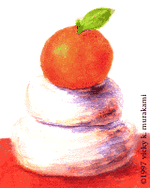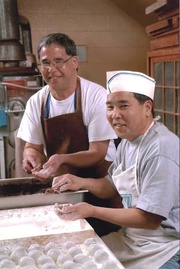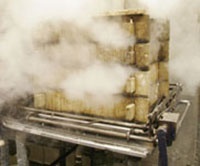NOW:
As we near the end of the year and the beginning of a new year, many Japanese American organizations (churches, cultural centers and museums) sponsor programs relating to Oshogatsu (New Year as celebrated by Japanese). Programs abound featuring the preparation of the many traditional Oshogatsu foods, which includes the production of mochi or mochitsuki. The hands-on labor intensive pounding of cooked sweet rice (mochigome) with a wooden mallet (pestle) called kine1 in an usu (mortar)2 is the traditional method used in Japan and by the subsequent generations of Japanese in America.
Today though, mochi can be produced using non-traditional means with a home appliance that automatically cooks the rice and then “whips” the rice into the glutinous glob that we know as mochi. You can even mix sweet rice flour with water, microwave it, stir it, microwave it again, stir it again and repeat until you end up with the same consistency of pounded mochi.
Regardless of how mochi is made, it is used primarily in three ways:
One, in the traditional “must have” Ozoni soup, which varies in ingredients from family to family depending on the region of Japan they originated from, but mochi is always included. Having ozoni ensures a happy, healthy and prosperous new year.
Secondly, mochi formed into two slightly different dome-shaped sizes and cooled are stacked with a mikan (mandarin) orange with its stem and a leaf placed on top, called Kagami mochi or Okasane and usually placed in the family’s home religious altar, on the fireplace mantel, or other places of prominence and honor.
The third, and a favorite of many—especially the children—is simply a piece of mochi baked to a near-burnt melt with a slightly toasted crust that is then eaten with shoyu (soy sauce) and sugar.
THEN:
This all serves to remind me of my mochi making days. Please allow me to reminisce and describe my experience helping in the annual mochitsuki at my grandfather, Suyeichi Okamura’s Benkyodo, a Japanese confectionary shop (Manju-ya) founded in 1906 San Francisco.
Back in the 1950s, when we grandchildren, Sansei (third generation Japanese in America), reached an age when our grandparents and parents determined that we would not get in the way and could actually help in some way, we were invited to join the longed for membership in the annual Benkyodo family ritual of producing mochi. In those days, Benkyodo was one of the main sources of mochi for San Francisco, the greater Bay Area, and Northern California’s Japanese American family’s Oshogatsu.
NOW:
This family coming together still continues today. My Sansei cousins Rick Okamura (R), along with his brother Bobby (L), still manage Benkyodo and offer interested family members, the annual opportunity to join in and help make mochi.
So does Brian Kito, Sansei owner/operator of Fugetsudo in Little Tokyo Los Angeles. “We invite our nephew and nieces and any family members interested in helping us produce mochi in readiness for Oshogatsu.”
THEN:
When younger, we kids would carry away wooden trays filled with mochi pieces hand-formed by the adults and we’d spread the trays out in another room or in the backyard, weather permitting, to let the mochi cool and harden after which we would brush the rice flour, used to keep them from sticking to each other, off the mochi and put them into containers from which they were sold in the store or packaged to fill orders placed in advance for later pick-up by the customers. I recall counter tops filled with an enormous amount of packages of mochi with the different family names on them.
When we were older teenagers, my brother Stan, cousin Hiro Okamura, and I would wash rice in large galvanized cans. The rice was more heavily talc-coated in those days. We would dump a sack of rice into the can, fill it half-way with water and swish the rice around back and forth using a wood paddle mounted on the end of a crisscrossed pair of wood poles. We would do this repeatedly until the water was clear. Brian Kito uses a similar paddle today as shown in the photo to the right. Like Brian, Benkyodo would wash the rice and let the many cans filled with clean rice soak overnight to be cooked the next day.
The washed sweet rice is scooped into many Seiro3 and stacked over a steamer to cook. This was another job that we graduated to as we got older. When we felt even more confident, we were given a turn at hand-pushing the very hot cooked rice to center it below the heavy rising kine before it dropped to pound the raised mound we had just formed. This was truly a challenging coming-of-age experience—hot, scary, and exciting!
NOW:
Today, in both Benkyodo and Fugetsudo, when the rice within the bottom seiro is cooked, the mechanical device at the base clamps and lifts all but the bottom seiro, which is removed and the cooked rice put into their respected pounding machine. At Fugetsudo it goes into the pictured unit below that has a blade at the bottom, which slap-pounds the hot rice into mochi consistency.
Benkyodo has both the old (pounder) and the new pounder with “bells and whistles,” which is used for their major mochi production. Rick said he still uses his “old” kine and usu occasionally, but the new machine (green) has some new major differences and technological changes which takes over the need for a person to keep the hot rice in the middle of the usu under the pounding kine.
This kine is made of high impact white plastic and the usu is made of steel and the usu bowl lining has two Teflon-coated sections, one which is a stationary collar and the bottom section that turns counter-clockwise and is ribbed with blades to turn the hot rice over toward center and the pounding kine. Not only that, the machine senses when water and air is needed and automatically squirts and blows the right amount of each. Rick said, “I don’t have to touch the hot rice at all and the whole automated pounding action takes only 3 minutes!”
THEN:
In the 1950’s Benkyodo, after the very hot sweet rice (mochigome) was finished cooking, Benkyodo used ropes and pulleys to lift the seiro stack up off the bottom seiro. The seiro was emptied of its steam cooked rice into the stone usu for the hands-on pushing and folding of the hot rice to center it under the ever falling and pounding kine.
After the pounding, the hot rice is now a homogenous mass the size of a deflated beach ball. This hot mass is gingerly scooped out of the usu and tossed onto a large table covered with rice flour. Around the table are up to six family members, aunts, uncles, mothers, and even precocious youngsters ready to receive a portion of the mochi mass which is cut into workable sizes with a wooden blade and thrown to each waiting person. For this particular batch everyone would pinch off roughly bun-sized pieces and placed them on rice floured wooden trays.
Depending on customer orders, in other batches of mochi, an experienced adult would cut and form the larger and slightly different sized pieces and hand-shape them into the beautiful Okasane sets, as we youngsters looked on in awe. When placed on trays to cool, they had to be treated more delicately so that they would retain their perfect domed shape. When a youngster was given the task to carry the tray to the cooling area, he or she must have felt honored and trusted with the special responsibility. I know I did.
NOW:
Both Benkyodo and Fugetsudo have recently celebrated their centennial under the capable hands of the third generation Sansei of the Okamura and Kito families. Rick and Bob Okamura and Brian Kito have mastered the artistry and skill to produce wagashi (various Japanese confectionaries) and successfully carry-on the traditional family businesses established by each of their proud grandfather and carried on and passed along to them by their father.
While mochitsuki for Oshogatsu is an annually heighten activity, mochi is still produced on a smaller scale as needed for many of the various mochigashi. Producing beautiful and delicious wagashi is a daily and a year around commitment and is the mainstay of the Japanese confectionary business.
Although it’s sad to see that the old method is being taken replaced by modern technology, I’m sure it will be awhile before the gathering of the Benkyodo and Fugetsudo families ceases and that the warm bonding and learning time continues to take place in hand-forming the mochi for Oshogatsu. I hope that the old fashioned and more visually exciting manual pounding of mochi will continue to be preserved and presented by the Japanese American organizations that do a great job to help to keep our Japanese culture alive and interesting.
Akemashite Omedeto Gozaimasu! – Happy New Year!
* Special thanks to Brian Kito, Fugetsudo; Rick and Bob Okamura, Benkyodo and Lori Matoba-Wun for their time, information, and photographs.
** The author reedited the last sections of this article on January 26, 2010 to make some clarifications based on the readers’ comments and suggestions.
Notes:
1. kine(杵): n. A pestle; a pounder.
2. usu(臼): n. A mortar; a hand-mill (挽臼)
usu-ishi(臼石)– a millstone;
usu de tsuku(臼で搗く)– beat (pound) <<rice, etc>> in a mortar.
3. seiro(蒸籠): n. A steaming basket; a steamer.
© 2009 Gary T. Ono












